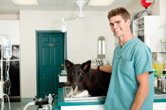Buying a veterinary practice can be a rewarding experience that allows you to earn a living while helping animals in need. Instead of building a new veterinary practice from the ground up, you can purchase a pre-existing practice with all of the employees, equipment and clientele already in place. It’s important to note, however, that not all pre-existing veterinary practices are smart investments. Purchasing the wrong one could end up draining both your time and financial resources. To help prevent this from happening, I have compiled the following buying tips listed below.
1. Financial Review
Of course the most important tip when buying a veterinary practice is a complete review of the practice historical and current financials. The saying goes, “numbers never lie” and a thorough financial review will give you great insight into the value of the practice moving forward. Keep an eye out for down years or downward revenue trends. This will give you talking points to discuss with the seller. He/She may have reasonable explanations, but if he/she doesn’t, you may want to steer clear of the practice. We see many times when a buyer let’s tunnel vision get in the way of common sense. It is important to determine the reasons for the downtrend and if they are fixable. Thinking that you can turn around a failing practice, without understanding the reason it is failing is a recipe for disaster.
2. Staff
A veterinary practice relies on an experienced, qualified staff to operate successfully. When you are shopping around for a practice, do a thorough examination of its staff to determine whether or not they seem capable of running the place. It’s oftentimes difficult to find new veterinary associates that have experience in exotic birds and pets. Having a full, experienced staff at your disposal will make your job ten times easier once the practice is in your name.
3. Returning Clients
Don’t be afraid to ask the current owner of the veterinary practice the client retention/bonding rate. This will give you an idea of overall customer satisfaction at the practice. While an average bonding rate of 60% is good, a higher figure like 80%-90% would be better. When a large percentage of customers take their pet to a specific veterinary practice once but never return again in the future, there are likely underlying problems that need to be addressed. By offering quality services to both animal clients and human owners, a practice can achieve a high level of customer satisfaction.
4. Location, Location, Location
Of course, the veterinarian practice’s location is one of the most important elements you should consider. If the practice is located in some obscure part of town that’s difficult to find, you won’t receive a lot of new customers. This doesn’t necessarily mean that it’s a bad business decision, but location is a critical factor that can make or break a veterinary practice. Drive around the practice’s surrounding area to gauge the traffic. A populated, high-traffic area will make your morning commute take a bit longer, but it’s also beneficial in terms of attracting new customers.
5. Brand
Does the veterinary practice have a solid name that people know and trust in the community? If it does, the practice will likely receive new customers strictly from word-of-mouth referrals. Practices which have spent their resources spreading the word about their brand are far more valuable than fly-by-night practices with no exposure.


